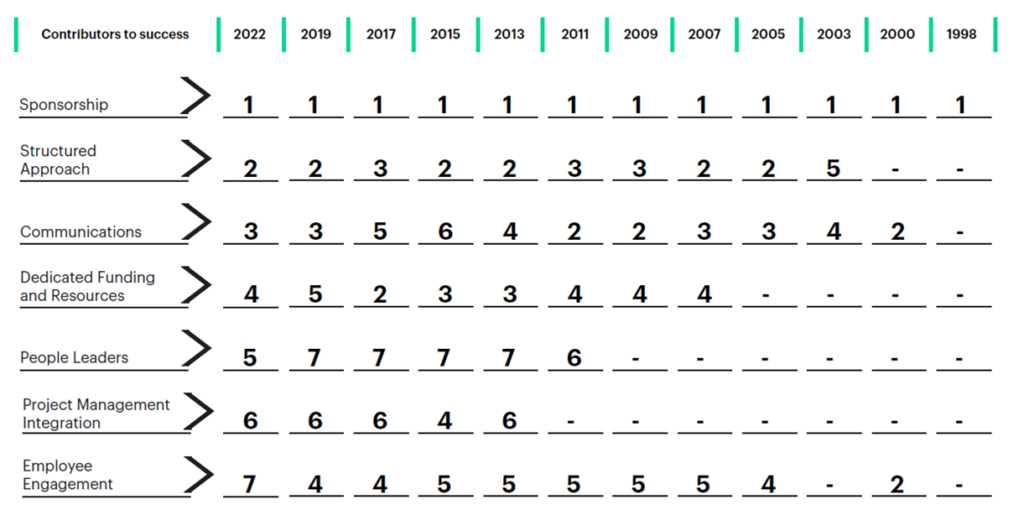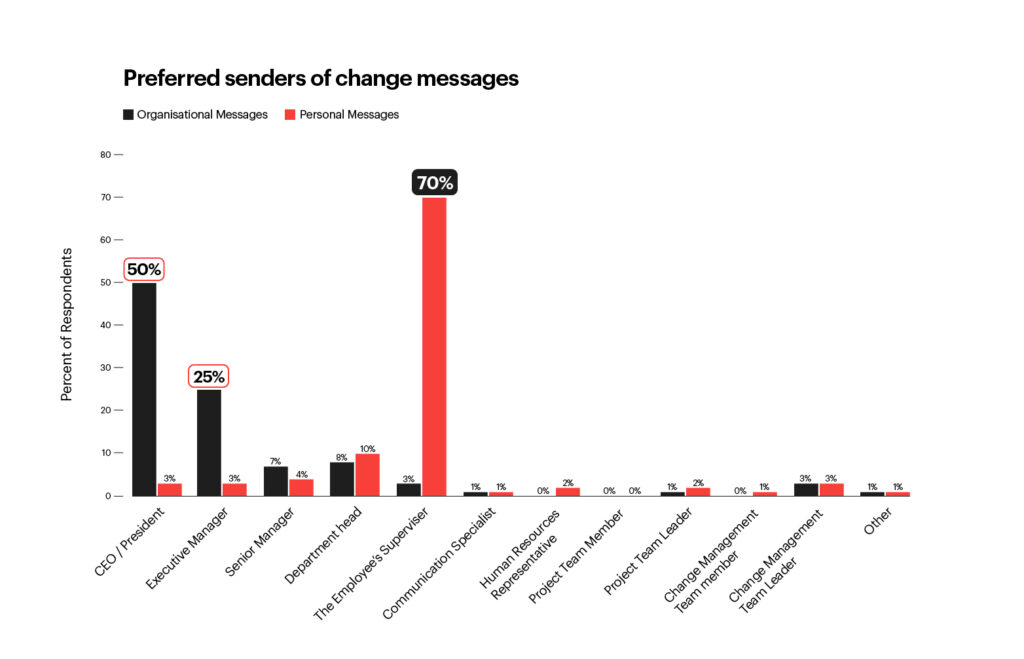A Communications Plan Is Not Change Management

Understand and Debunk the Communications Myth
One of the most common objections to change management is the misguided belief that communications plans are all you need to manage change. This is a myth change practitioners know well, but others in your organization may not. Debunking it is critical to bringing change management into your organization for both project changes and organizational competency.
Prosci Best Practices in Change Management research consistently identifies active and visible executive sponsorship as the number one contributor to overall project success. A structured change management approach is number two. Frequent, open communication is important to change management but ranks fourth on the list. Other factors play a greater role in implementing your change well and meeting objectives.
To challenge the communication-is-enough myth successfully, use benchmarking data and examples from your organization to reveal success factors other than communication. The Best Practices in Change Management report includes the top contributors to success and insights into each of the different change management tools.
The research findings suggest that communications are not the primary driver of the success of change initiatives, highlighting the multifaceted nature of organizational change. While effective communication is important in facilitating Awareness of the change, it is not the sole factor that determines success. Other roles, particularly active and visible sponsorship, play pivotal roles in driving successful change efforts, as demonstrated below.

The ABC’s of Sponsorship: Sponsorship requires the senior leaders and executives the champion the change effort by actively demonstrating their commitment to it. Here’s how they do this.
- Active and Visible: When senior leaders visibly support and actively participate in the change, they lend credibility and influence to the initiative. Employees are more likely to embrace change when they see their leaders fully engaged and invested in it.
- Build a Coalition: Sponsors must build coalitions with other sponsors to demonstrate a unified front in supporting the change. This ensures that all sponsors are pulling in the same direction, reinforcing the consistency and strength of the change effort. By aligning sponsors and fostering collaboration among them, the coalition can amplify the impact of sponsorship and drive the change initiative more effectively.
- Communicate Effectively: Effective communication is only one part of a sponsor’s role in supporting change. It entails conveying clear and consistent messages to all stakeholders through various channels. Effective communicators ensure that information is not only disseminated but also understood, addressing questions and concerns while fostering a sense of transparency and trust throughout the organization.
A Certified Change Practitioner plays a crucial role in preparing the sponsor roadmap for the sponsors by leveraging their specialized knowledge and expertise in change management. They help sponsors understand the nuances of each element of the ABC’s (Active and Visible, Build a Coalition, Communicate Effectively) and tailor strategies to the specific context of the organization and its change initiative. This ensures that sponsors are well-equipped with a comprehensive plan, guidance, and the necessary tools to effectively fulfill their roles in driving successful change, ultimately enhancing the chances of a smooth and successful transformation.
People can’t change what they don’t know. Your job is to show the organization that change management is more than just communication. It’s a holistic process for implementing change successfully in an organization. It’s the set of tools that enables managers to accelerate the speed of adoption and overall participation in change.
Change management is a process, which requires understanding all elements of the change and moving through the change management process. You must also develop change management plans to support the change at the organizational level. These start with the ADKAR Blueprint and core plans, including the Sponsor Plan, People Manager Plan, Training Plan and Communications Plan, along with any extend plans you need, such as a Resistance Management Plan. And don’t forget that from the individual perspective, change management is about helping employees move through awareness, desire, knowledge, ability and reinforcement (ADKAR Model). The process is far more involved than simply communicating.
Although project teams may have communications plans, they may not be sending the right messages. It’s important to teach those individuals the ADKAR Model, which describes the building blocks of successful change and the information to communicate to help individuals go through it. Understanding all this, those who develop the communications plans are better able to focus on the key outcomes they’re trying to achieve with change. Instead of offering only communications, project changes that leverage the ADKAR Model build awareness and desire, focusing individuals on the outcomes you want to achieve and enhancing the overall impact of organizational communications. Choosing the right tool for each ADKAR element also matters. You can’t train awareness and you can’t communicate ability. Your job is to ensure that the communications plan focuses on the ADKAR building blocks they affect.
Best practices research reveals two preferred senders of messages related to change. When it comes to the business reasons for the change, employees want to hear from the senior leaders authorizing and funding the change. They want to understand why the change is taking place, risks of not changing, and competitive and customer issues. When the message concerns the personal impacts of the change, or “What’s In It For Me” (WIIFM), employees want to hear from their immediate supervisors. A communications plan that does not incorporate these findings will be less effective.
You need to prepare senior leaders to deliver business messages. You also need to prepare supervisors to deliver messages about how the change impacts employees specifically. Effective communications plans send the right messages to the right audiences at the right time and from the right sender.

Project teams can fall into the trap of being centrally focused on the future state and ignoring communication about the current state. It makes sense that project teams focus on their solution. You want your project teams to be consumed with capturing opportunities and solving problems. However, because project teams live in the context of the future state, it influences the content of a communication plan.
Ensure that your communications plans answer the questions that employees want answered. Today’s empowered workforce asks questions about the reasons behind the change and not just the future state. A communication plan that focuses on the future state misses the point. In fact, research shows that the top reason for employee resistance to change is not understanding why a change is taking place. And a general communications plan that ignores change management principles and best practices may not address this root cause of resistance.
Communication in the organization must be targeted to the audience and answer their specific questions and concerns to be effective, which means talking about both the current state as well as the future state.
Change Management Is More Than Communication
Project teams are a key source of information and details about the change, and they will be crucial partners in your efforts to integrate change management and project management activities. Understanding the most common change management myths and objections, including the communication-is-enough myth, will help you facilitate more successful changes with your project leaders and team members.